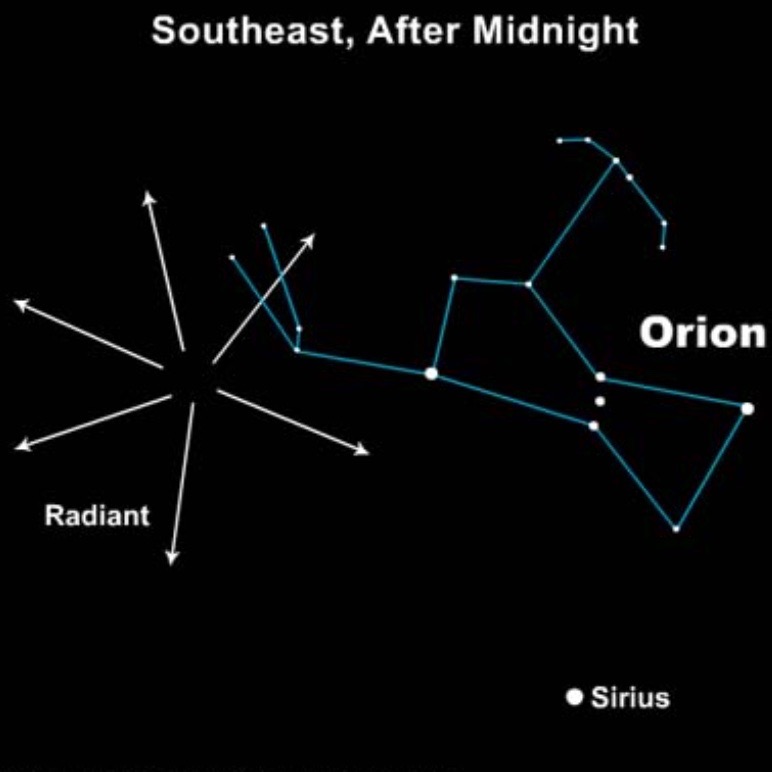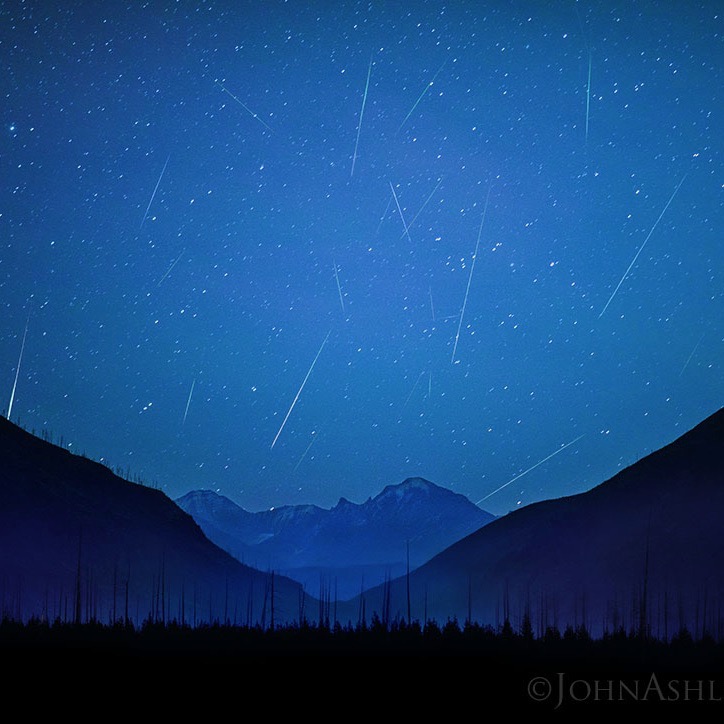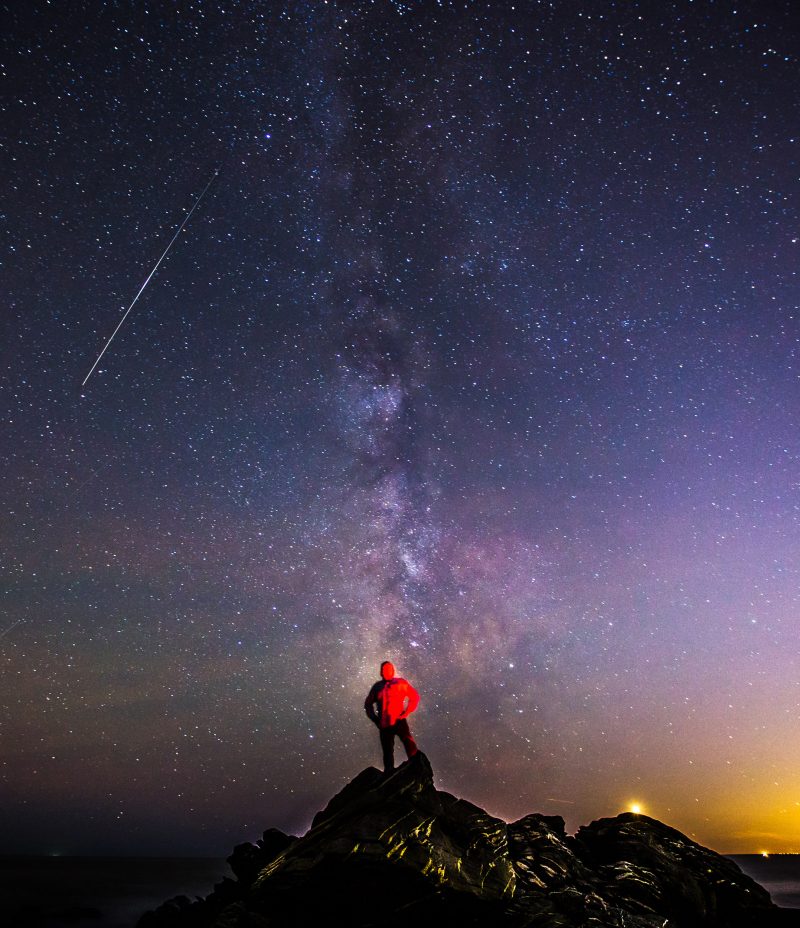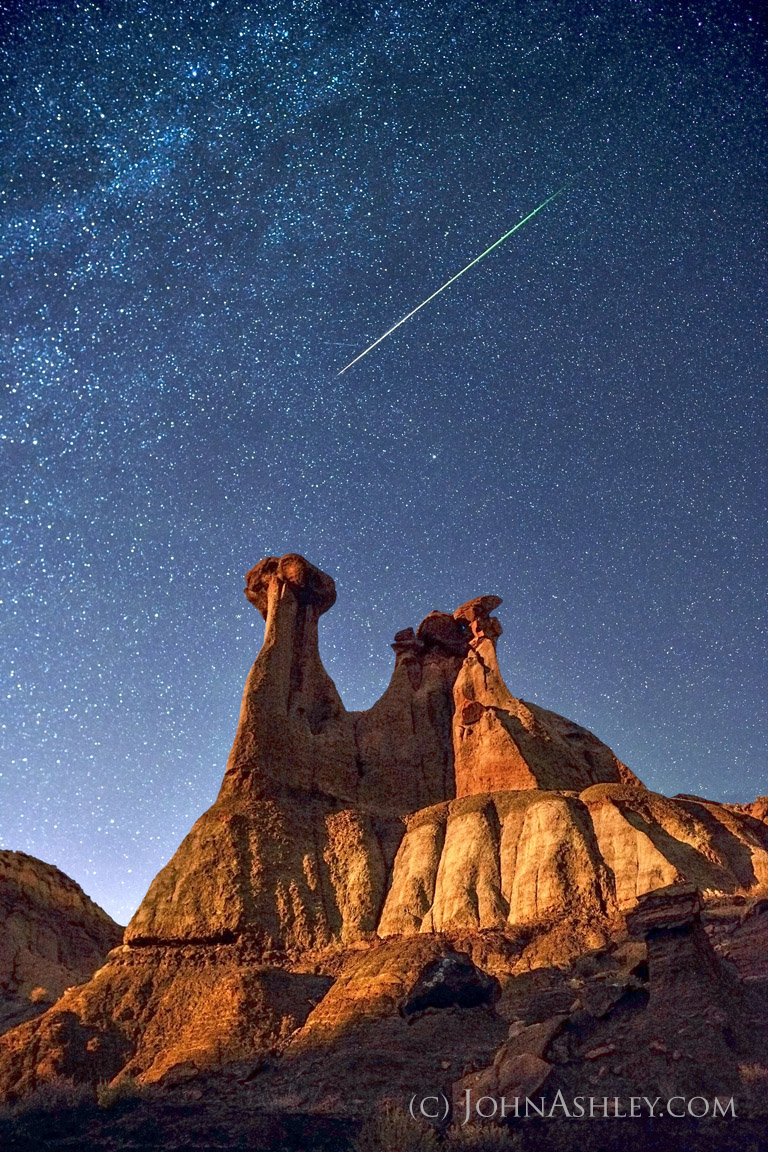
Orionid meteor shower begins
Orionid meteors fly each year between about October 2 to November 7. That’s when Earth is passing through the stream of debris left behind by Comet Halley, the parent comet of the Orionid shower. The Orionids usually put out the greatest number of meteors in the few hours before dawn. And the expected peak morning in 2021 is October 21. Bad news for Orionid fans this year, though. The 2021 full Hunter’s Moon will be October 19-20. That means moonlight will flood the sky all night, or nearly all night, during the Orionids’ peak.
But you might see an Orionid meteor at any time during October, assuming you’re a dark location, with a sky free of moonlight.
The term meteor shower might give you the idea of a rain shower. But few meteor showers resemble showers of rain. The Orionids aren’t the year’s strongest shower, and they’re not particularly known for storming (producing unexpected, very rich displays). From a dark location, in a year when the moon is out of the way, you might see 10 to 20 Orionids per hour at their peak. Will you see that many in 2021? Not likely. There’s always the element of uncertainty and possible surprise when it comes to meteor showers. But no one expects that many Orionids to overcome the moon’s glare, during 2021’s shower.

If you do see any Orionids in 2021, note that they’re known to be extremely fast meteors, plummeting into the Earth’s atmosphere at about 41 miles (66 km) per second. The meteors in this shower are on the faint side. But they make up for their faintness by leaving trains, or ionized gas trails that last for a few seconds after the meteor itself has gone. Maybe half of the Orionid meteors leave persistent trains.
Also, sometimes, an Orionid meteor can be exceptionally bright and break up into fragments.
How will you know the meteor you see is an Orionid? You’ll know because it’ll come from the shower’s radiant point. See the chart at top.

Orionid meteors radiate from constellation Orion
Meteors in annual showers are named for the point in our sky from which they appear to radiate. The radiant point for the Orionids is in the direction of the famous constellation Orion the Hunter, which you’ll find ascending in the east in the hours after midnight during October. Hence the name Orionids.
You don’t need to know Orion, or be staring toward it, to see the meteors. The meteors often don’t become visible until they are 30 degrees or so from their radiant point. And, remember, they are streaking out from the radiant in all directions. They will appear in all parts of the sky.
But if you do see a meteor – and trace its path backward – you might see that it comes from the Club of Orion. And, if so, that meteor will be an Orionid. You might know Orion’s bright, ruddy star Betelgeuse. The radiant is north of Betelgeuse.
So … in which direction do you look? No particular direction. It’s best to find a wide-open viewing area. Sometimes friends like to watch together, facing different directions. When somebody sees one, that person can call out meteor!

Orionid meteors stem from Comet Halley
Meteors are fancifully called shooting stars. But they aren’t really stars. They’re debris left behind by comets, burning up in the Earth’s atmosphere.
The Orionid meteors are debris left behind by Comet Halley, arguably the most famous of all comets, which last visited Earth in 1986. This comet leaves debris in its wake that strikes Earth’s atmosphere most fully around October 20-22, while Earth intersects the comet’s orbit, as it does every year at this time.
Particles shed by the comet slam into our upper atmosphere, where they vaporize at some 60 miles (100 km) above Earth’s surface.
Even one meteor can be a thrill. But – in many years, when the moon is out of the way – you can enjoy looking skyward for an hour or more, for the bright streaks from Comet Halley. That won’t be the case in 2021, with full moon so near the shower. But the Orionids are a long-lasting shower. Maybe you’ll see one!

Bottom line: In 2021, the Orionid meteor shower is expected to rain down its greatest number of meteors on the morning of October 21. But the moon, just past full, will interfere.
EarthSky’s meteor shower guide for 2021
The post Orionid meteor shower: All you need to know first appeared on EarthSky.
from EarthSky https://ift.tt/3ueeZu8

Orionid meteor shower begins
Orionid meteors fly each year between about October 2 to November 7. That’s when Earth is passing through the stream of debris left behind by Comet Halley, the parent comet of the Orionid shower. The Orionids usually put out the greatest number of meteors in the few hours before dawn. And the expected peak morning in 2021 is October 21. Bad news for Orionid fans this year, though. The 2021 full Hunter’s Moon will be October 19-20. That means moonlight will flood the sky all night, or nearly all night, during the Orionids’ peak.
But you might see an Orionid meteor at any time during October, assuming you’re a dark location, with a sky free of moonlight.
The term meteor shower might give you the idea of a rain shower. But few meteor showers resemble showers of rain. The Orionids aren’t the year’s strongest shower, and they’re not particularly known for storming (producing unexpected, very rich displays). From a dark location, in a year when the moon is out of the way, you might see 10 to 20 Orionids per hour at their peak. Will you see that many in 2021? Not likely. There’s always the element of uncertainty and possible surprise when it comes to meteor showers. But no one expects that many Orionids to overcome the moon’s glare, during 2021’s shower.

If you do see any Orionids in 2021, note that they’re known to be extremely fast meteors, plummeting into the Earth’s atmosphere at about 41 miles (66 km) per second. The meteors in this shower are on the faint side. But they make up for their faintness by leaving trains, or ionized gas trails that last for a few seconds after the meteor itself has gone. Maybe half of the Orionid meteors leave persistent trains.
Also, sometimes, an Orionid meteor can be exceptionally bright and break up into fragments.
How will you know the meteor you see is an Orionid? You’ll know because it’ll come from the shower’s radiant point. See the chart at top.

Orionid meteors radiate from constellation Orion
Meteors in annual showers are named for the point in our sky from which they appear to radiate. The radiant point for the Orionids is in the direction of the famous constellation Orion the Hunter, which you’ll find ascending in the east in the hours after midnight during October. Hence the name Orionids.
You don’t need to know Orion, or be staring toward it, to see the meteors. The meteors often don’t become visible until they are 30 degrees or so from their radiant point. And, remember, they are streaking out from the radiant in all directions. They will appear in all parts of the sky.
But if you do see a meteor – and trace its path backward – you might see that it comes from the Club of Orion. And, if so, that meteor will be an Orionid. You might know Orion’s bright, ruddy star Betelgeuse. The radiant is north of Betelgeuse.
So … in which direction do you look? No particular direction. It’s best to find a wide-open viewing area. Sometimes friends like to watch together, facing different directions. When somebody sees one, that person can call out meteor!

Orionid meteors stem from Comet Halley
Meteors are fancifully called shooting stars. But they aren’t really stars. They’re debris left behind by comets, burning up in the Earth’s atmosphere.
The Orionid meteors are debris left behind by Comet Halley, arguably the most famous of all comets, which last visited Earth in 1986. This comet leaves debris in its wake that strikes Earth’s atmosphere most fully around October 20-22, while Earth intersects the comet’s orbit, as it does every year at this time.
Particles shed by the comet slam into our upper atmosphere, where they vaporize at some 60 miles (100 km) above Earth’s surface.
Even one meteor can be a thrill. But – in many years, when the moon is out of the way – you can enjoy looking skyward for an hour or more, for the bright streaks from Comet Halley. That won’t be the case in 2021, with full moon so near the shower. But the Orionids are a long-lasting shower. Maybe you’ll see one!

Bottom line: In 2021, the Orionid meteor shower is expected to rain down its greatest number of meteors on the morning of October 21. But the moon, just past full, will interfere.
EarthSky’s meteor shower guide for 2021
The post Orionid meteor shower: All you need to know first appeared on EarthSky.
from EarthSky https://ift.tt/3ueeZu8

Aucun commentaire:
Enregistrer un commentaire